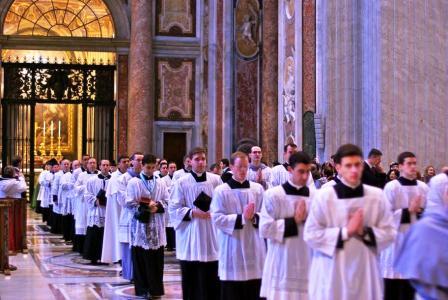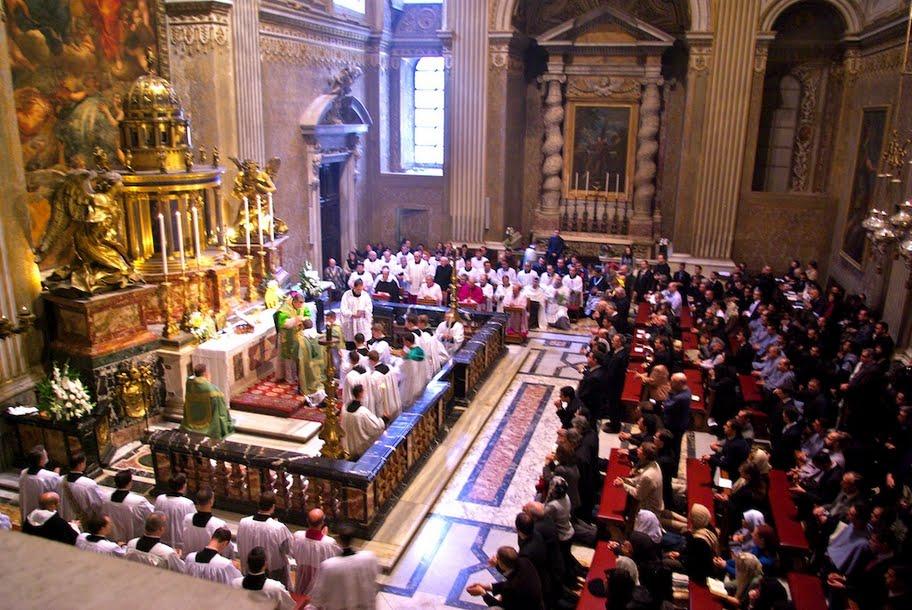Here is an interesting slant, and I use that word with care, on Sunday’s Pontifical Mass in the Vatican Basilica celebrated by His Excellency Most Rev. Raymond Burke, Prefect of the Segnatura.
My emphases and comments.
Archbishop Burke celebrates Tridentine Mass in St. Peter’s Basilica
By Cindy Wooden
Catholic News ServiceVATICAN CITY (CNS) — The Gregorian chant of the Tridentine Mass [… of the Roman Rite…] filled the Blessed Sacrament Chapel of St. Peter’s Basilica Oct. 18 as U.S. Archbishop Raymond L. Burke, head of the Vatican’s highest court, celebrated a pontifical high Mass.
The Mass marked the liturgical close of a conference in Rome on Pope Benedict XVI’s 2007 apostolic letter, "Summorum Pontificum," which expanded permission for the celebration of the Mass using the 1962 Roman Missal, commonly known as the Tridentine rite.
Cardinal Angelo Comastri, archpriest of St. Peter’s Basilica, said in a statement Oct. 19, "The Mass represented an extraordinary event, an event authorized on the occasion of the conference." [Any number of special Masses are held in the Vatican Basilica because of the visit of some group or event. I receive the monthly newsletter of the Basilica of St. Peter. For example, on the morning of 5 August, His Eminence Antonio Canizares Llovera celebrated Mass at the Altar of the Cathedra for a group of 200 Spanish pilgrims and 14 priests concelebrated. That was an extraordinary event. However, I think the writer quoted this in such as way as to suggest that the Mass was a one time deal, probably not to become usual.]
The cardinal declined further comment, but another Vatican official said the Mass probably [probably?] was the first pontifical high Mass using the 1962 rite to be celebrated in St. Peter’s Basilica in almost 40 years.
The same official noted that since the publication of "Summorum Pontificum," any priest in good standing has been able to use the 1962 rite to celebrate Mass at one of the side altars or in one of chapels of the basilica. He said there are priests who do so each morning.
Unlike a low Mass, a high Mass is sung. Calling a Mass "pontifical" means it is celebrated by a bishop, who is assisted by a deacon and subdeacon. The main text of the liturgy is the same, although the vestments, furnishings and movements are more complex at a pontifical high Mass.
Even before "Summorum Pontificum" was published, the Vatican had given limited permission for the celebration of the old Mass in the basilica.
[Read this next part and ask yourself why it was included in this article.]
In 2003 [this is 2009] the Vatican Secretariat of State published norms for the celebration of Masses in the basilica using the 1962 Missal. The norms set several conditions:
— The Mass could not be celebrated in the main body of the basilica; a suggested site was the Hungarian Chapel in the grotto below the main church.
— The public could not be invited and no photographs were to be taken.
— The priest celebrating the Mass must first receive permission from the Pontifical Commission "Ecclesia Dei," which is responsible for the pastoral care of Catholics attached to the old liturgy.
In his 2007 letter, the pope said the Mass from the Roman Missal in use since 1970 remains the ordinary form of the Mass. [? … and?… what?…]
The day before Archbishop Burke celebrated the Mass in St. Peter’s Basilica, the Vatican announced that Pope Benedict had named him to be a member of the Congregation for Bishops, the Vatican office that oversees the nomination of bishops and the creation and governance of dioceses.
So, that last part was… what? Filler?
Not a single interesting note about the Mass itself.
The first Pontifical Mass in the Vatican Basilica in 40 years? And this was not interesting?
Nothing about the sermon given at this noteworthy Mass? Nothing about the music? Who was involved?
No report on the number of people who attended?
BTW… so many people showed up that they couldn’t get in.
Was there an article about the conference?
UPDATE:
A couple shots of what CNS didn’t cover. You would think that with all these clerics there, someone could have gotten a few quotes.




































This is an excellent example of “evasive journalism”. Appear to be covering an event while all that is really being reported is the occurrence of the event. Yes, you would think that something this extraordinary (no pun intended) would call for some detail about what actually took place, but no details are given (such as huge number of people) because the author apparently wants the reader to envision a pathetic one-time event given by a few old Bishops at an obscure conference that nobody cares about. The implication from the “documentation” is that this sort of thing is only just barely allowed and barely tolerated and that there is “no need to worry…the 1970 Mass is still the norm…the Pope says so!”.
Thanks for pointing out this article, Father. Your observations are spot on, but it’s not too surprising, considering the points of view of some of the sources (both inside and outside the Vatican) the reporter likely relied on to write the article.
I saw similarly styled articles in the mainstream (is that the correct term?) Catholic press when Cardinal Stickler celebrated a Pontifical High Mass in St Patrick’s Cathedral, NYC, back in 1996 (I think that was the year). The cathedral was absolutely packed (I arrived an hour early and still could only find a seat directly behind a pillar), people assisted at the Mass from the cathedral steps, and all that could be reported was “some retired Cardinal said the Old Mass last Sunday.”
For whatever reason, I think the sources in both situations had strong opinions to try to keep re-occurences to a minimum. And if I’m not mistaken, there has yet to be another Pontifical High Mass at St Patrick’s to this day.
In Christ,
It’s basically a book report — look up a few sources, paste it together without too much thought or design, don’t work too hard on it. I would say that the paragraph distinguishing low, high, and pontifical Masses is very nicely done. And presumably she asked Cardinal Comastri for further comment, but as she reported, he declined. So perhaps we shouldn’t put all the blame on Ms. Wooden.
“In his 2007 letter, the pope said the Mass from the Roman Missal in use since 1970 remains the ordinary form of the Mass.”
I have seen this line used over and over when reporters must cover a TLM story, or even when a Priest or Bishop comments on the TLM. They cling to this line because it is all they have left.
In 2007 when the Canadian Bishops met, the Nuncio addressed them to speak of various documents released by the Vatican that year, this was ALL he said about Summorum Pontificum:
“Second, the Motu Proprio Summorum Pontificum, of July 7 and which came into effect on September 14. In his explanatory letter addressed to all the Bishops, the Pope wanted to ensure that the Rite established by Paul VI would remain the normal liturgical form.”
Thats it. I kid you not. He actually quoted a line from the explanatory letter without saying anything about the document itself. This is what liberal commentators must do in order to put a spin on a document that they are clearly opposed to, without looking like they are opposed to the Pope himself, which of course they are.
Okay, I have a question. The article says,
“Calling a Mass “pontifical” means it is celebrated by a bishop, who is assisted by a deacon and subdeacon.”
How can a bishop be assisted by a subdeacon is there are no longer subdeacons? Or is this a description of a role in the Mass rather than one’s particular state of ordination? [It is a description of a role.]
Not too many gray hairs or “natural tonsures” in that picture!
There were Franciscans of the Immaculate in attendance and I believe the sisters provided the vocals.
I am more annoyed with the phrase “The Gregorian chant of the Tridentine Mass…” Gregorian Chant, as well as Latin, belongs to the Roman Rite, both in its Ordinary Form and in its Extraordinary Form! Grrr!!!
Geoffrey: If I wrote “The Gregorian chant of the Ordinary Form Mass filled the Church of St. Agnes” would you accuse me of claiming that one can only find Gregorian chant in the new Mass?
[2003 Secretariat of State:] “The public could not be invited and no photographs were to be taken.” “Wide and generous,” that.
Beautiful photos, btw.
and I still don’t know what a ppntifical mass is …..
Why mention the 2003 rules?? Do they still try to abide by them? Why would the Vatican try to keep out the public if in fact the Mass was not suppressed or abrogated? Well I know the answers to my questions but it does sound downright indecent..Now they want it to become a part of the life of the Church, no wonder there is so much confusion when people wonder what they can and can not do. The Holy Father has given such a gift to the whole Church it still stings a little when you read about how things were just a few years ago and all the moves to obstruct people’s access to the Tridentine Mass. I can say that they succeeded in doing so for many millions. I wonder when you get to the bottom line, if it was better for the souls..I doubt it..
Greg: My comment was directed at the mistaken notion that Latin and chant is reserved for the old Mass, whereas guitar music and the vernacular are reserved for the new Mass.
Agree with NLucas. The SO frequent not-so-subtle spin is: “Oh, isn’t this quaint; a little oddity off in a corner somewhere–but don’t worry folks, nothing has really changed. Move along–nothing to see here.”
Cindy Wooden is notorious for articles such as this one. CNS is the Soviet Pravda of its day. Its agenda is to present facts and events as they would want them to be, not as they really are. But, other than on this blog, nobody is going to call them out on it. Infuriating.
Thank you for covering this, Father. Here and Robert Moynihan’s email letters are the only places I have heard the news of this glorious event. Par for the course – just as in the secular media, certain groups only publish what they want you to know, if it promotes their agenda. Yep, agree with you, TNCath.
Greg: My comment was directed at the mistaken notion that Latin and chant is reserved for the old Mass, whereas guitar music and the vernacular are reserved for the new Mass.
Comment by Geoffrey — 19 October 2009 @ 9:09 pm
Geoffrey – are you saying that this Sunday I might get guitar music at my local TLM? :)
I’d like to see guitar music reserved for the parish hall. Don’t get me started on my old parish’s use of bongos and wind chimes!
Thanks for clarifying, Fr. Z.